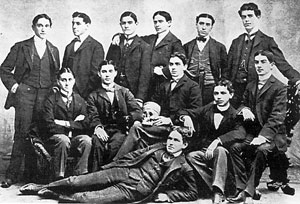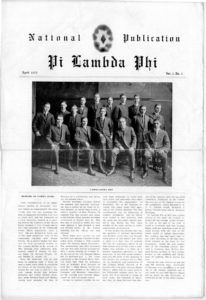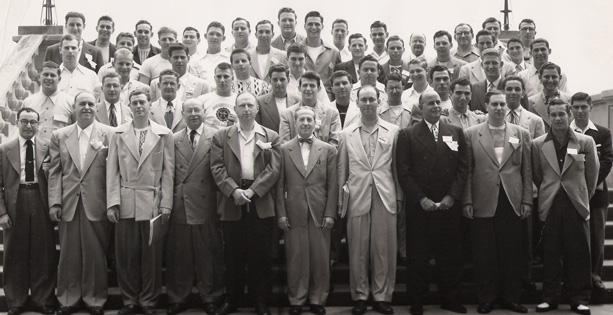World War II and Beyond
February 1, 1941 witnessed the union with Phi Beta Delta Fraternity, which had been founded by eight men at Columbia University in 1912. The merger was successful because Phi Beta Delta was similar to Pi Lambda Phi in many areas. Both fraternities shared a belief in non-sectarianism and placed a heavy emphasis on scholastic achievement.
At the time of the union, Pi Lambda Phi had 20 active chapters, while Phi Beta Delta had 16. Deducting duplicate chapters, the united fraternity at the time of the merger had a total of 33 active undergraduate chapters. For over half a century now, many of the chapters from Phi Beta Delta have remained strong chapters of our fraternity.
The fiftieth anniversary of the founding of Pi Lambda Phi was scheduled for March 21, 1945, but had to be postponed due to the war and the 3,000 Pilam brothers in the armed forces. The post-war era helped to revive a fraternal system that struggled to keep afloat during the Second World War. The influx of servicemen returning to civilian life and college campuses provided a well-needed boost. Pilam chapters that were forced to suspend their operations due to the war were revitalized with renewed commitment to the ideals and principles on which they were founded.
In November of 1960, Beta Sigma Tau Fraternity merged into Pi Lambda Phi. Beta Sigma Tau as founded in May of 1948, at the National Conference of Intercultural Fraternities held in Chicago, IL. It was the first national interracial and interreligious college social fraternity to be organized following World War II. Although Beta Sigma Tau expanded rapidly to seventeen college campuses from 1948 to 1952, only six chapters remained by 1959. Of these six chapters, three were voted into the brotherhood by the Pilam active chapters. These three chapters were located at Ohio State University, Ohio Wesleyan University and Baldwin Wallace University. Unfortunately, Ohio State and Ohio Wesleyan did not survive the early 60s.
The 1960s were characterized by campus unrest brought about by the Vietnam War and the controversies it provoked. It was a time of “dropping out,” and this included fraternity participation. Some chapters literally disappeared overnight, and the age of drug experimentation was ushered in on many campuses. Despite the times, Pi Lambda Phi continued to courageously lead the way in eliminating prejudice. In April 1969, we reactivated our Virginia Omega Alpha Chapter at the University of Virginia (UVA), which had been forced to close during World War II. True to our Creed, Pi Lambda Phi initiated the first African-American into an NIC fraternity on that campus.
On December 12, 1972, Beta Sigma Rho merged into Pilam. Beta Sigma Rho was organized under the name Beta Samach, the Greek Beta and the Hebrew Samach suggesting the application of the Greek society idea to the social and cultural life of the Jewish undergraduate.
In 1991, in order to facilitate modernization of our organization, we adopted a new International Constitution that among other things reduced the unwieldy size of the National Council from forty-two members.
In March 1995, the fraternity celebrated its milestone 100th anniversary with a tribute to our Founders, at the site of our founding, Yale University in New Haven, Connecticut.




 During the fall of 1916, a group of alumni organized a convention to discuss centralization of authority, administration, and general national policy. The result was a new national constitution, which provided for government of the Fraternity through a National Council, similar to the way we operate today.
During the fall of 1916, a group of alumni organized a convention to discuss centralization of authority, administration, and general national policy. The result was a new national constitution, which provided for government of the Fraternity through a National Council, similar to the way we operate today.